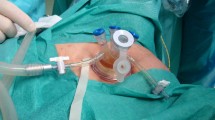Abstract
Most patients presenting cystinuria require multiple urological procedures during their lifetime. In this kind of patients the availability of minimally invasive procedure represents an advantage of minimizing the cumulative morbidity of several repeated treatments. Herein we report our experience using ureterorenoscopy (URS) for the treatment of recurrent renal cystine stones. From 2003 to 2007, 10 patients (4 males and 6 females) with one or multiple recurrent renal cystine stones underwent URS. Overall, 21 procedures have been performed. Mean maximum diameter of stones was 11.2 mm (range 5–30 mm). Either 8–9.5 F semirigid or 7.9 F flexible ureteroscopes were used. In 6 cases, stones were removed using a basket; in 9 procedures laser lithotripsy with flexible scope was performed; in 6 cases renal calculi were pulled down in the ureter using flexible instrument and then shattered with laser introduced by semirigid instrument. Stone-free status was defined as the absence of any residual fragment. A complete stone clearance was obtained in 15 out of 21 procedures (71%). In 5 cases (24%) significant residual fragments occurred; in the remaining case (5%) URS was ineffective. In 5 out of these unsuccessful procedures, stone clearance was obtained with auxiliary treatments. The last patient has not been treated yet. No major complications occurred as a result of the procedures. URS offers excellent advantages in case of recurrent hard calculi such as cystine stones. Minimally invasive procedures allow satisfactory outcomes, improving patients’ quality of life.

Similar content being viewed by others
References
Tiselius HG (2005) Removal of ureteral stones with extracorporeal shock wave lithotripsy and ureteroscopic procedures. What can we learn from the literature in terms of results and treatment efforts? Urol Res 33:185–190
Tiselius HG, Ackermann D, Alken P, Buck C, Conort P, Gallucci M (2001) Guidelines on urolithiasis. Eur Urol 40:362–371
Paik ML, Wainstein MA, Spirnak JP, Hampel N, Resnick MI (1998) Current indications for open stone surgery in the treatment of renal and ureteral calculi. J Urol 159:374–379
Lingeman JE (1996) Lithotripsy and surgery. Semin Nephrol 16:487–498
Lingeman JE, Coury TA, Newman DM, Kahnoski RJ, Mertz JH, Mosbaugh PG, Steele RE, Woods JR (1987) Comparison of results and morbidity of percutaneous nephrostolithotomy and extracorporeal shock wave lithotripsy. J Urol 138:485–490
Havel D, Saussine C, Fath C, Lang H, Faure F, Jacqmin D (1998) Single stones of the lower pole of the kidney. Comparative results of extracorporeal shock wave lithotripsy and percutaneous nephrostolithotomy. Eur Urol 33:396–400
May DJ, Chandhoke PS (1998) Efficacy and cost-effectiveness of extracorporeal shock wave lithotripsy for solitary lower pole renal calculi. J Urol 159:24–27
Graff J, Diederichs W, Schulze H (1988) Long-term follow-up in 1003 extracorporeal shock wave lithotripsy patients. J Urol 140:479–483
Schmeller NT, Kersting H, Schuller J, Chaussy C, Schmiedt E (1984) Combination of chemolysis and shock wave lithotripsy in the treatment of cystine renal calculi. J Urol 131:434–438
Wang LP, Wong HY, Griffith DP (1997) Treatment options in struvite stones. Urol Clin North Am 24:149–162
Politis G, Griffith DP (1987) ESWL: stone-free efficacy based upon stone size and location. World J Urol 5:255–258
Netto NR Jr, Claro JFA, Lemos GC, Cortado PL (1991) Renal calculi in lower pole calices: what is the best method of treatment? J Urol 146:721–723
Locke DR, Newman RC, Steinbock GS, Finlayson B (1990) Extracorporeal shock wave lithotripsy in horseshoe kidneys. Urology 35:407–411
Sampaio FJB, Aragao AHM (1994) Limitations of extracorporeal shockwave lithotripsy for lower caliceal stones: anatomic insight. J Endourol 8:241–247
Elbahnasy AM, Clayman RV, Shalhav AL, Hoenig DM, Chandhoke P, Lingeman JE, Denstedt JD, Kahn R, Assimos DG, Nakada SY (1998) Lower-pole caliceal stone clearance after shockwave lithotripsy, percutaneous nephrostolithotomy, and flexible ureteroscopy: impact of radiographic spatial anatomy. J Endourol 12:113–119
Elbahnasy AM, Shalhav AL, Hoenig DM, Elashry OM, Smith DS, Mcdougall EM, Clayman RV (1998) Lower caliceal stone clearance after shock wave lithotripsy or ureteroscopy: the impact of lower pole radiographic anatomy. J Urol 159:676–682
Knoll T, Zöllner A, Wendt-Nordahl G, Michel MS, Alken P (2005) Cystinuria in childhood and adolescence: recommendations for diagnosis, treatment, and follow up. Pediatr Nephrol 20:19–24
Yiu MK, Liu PL, Yiu TF, Chan AYT (1996) Clinical experience with holmium:YAG laser lithotripsy of ureteral calculi. Lasers Surg Med 19:103–106
Coe FL, Evan A, Worcester E (2005) Kidney stone disease. J Clin Invest 115:2598–2608
Straub M, Strohmaier WL, Berg W, Beck B, Hoppe B, Laube N, Lahme S, Schmidt M, Hesse A, Koehrmann KU (2005) Diagnosis and metaphylaxis of stone disease Consensus concept of the National Working Committee on Stone Disease for the Upcoming German Urolithiasis Guideline. World J Urol 23:309–323
Katz G, Lencovsky Z, Pode D, Shapiro A, Caine M (1990) Place of extracorporeal shock-wave lithotripsy (ESWL) in the management of cystine calculi. Urology 36:124–128
Schuster TG, Russell KY, Bloom DA, Koo HP, Faerber GJ (2002) Ureteroscopy for the treatment of urolithiasis in children. J Urol 167:1813
Streem SB, Yost A, Mascha E (1996) Clinical implications of clinically insignificant stone fragments after extracorporeal shock wave lithotripsy. J Urol 155:1186–1190
Author information
Authors and Affiliations
Corresponding author
Rights and permissions
About this article
Cite this article
Ruggera, L., Zanin, M., Beltrami, P. et al. Retrograde transureteral approach: a safe and efficient treatment for recurrent cystine renal stones. Urol Res 39, 411–415 (2011). https://doi.org/10.1007/s00240-010-0358-2
Received:
Accepted:
Published:
Issue Date:
DOI: https://doi.org/10.1007/s00240-010-0358-2




